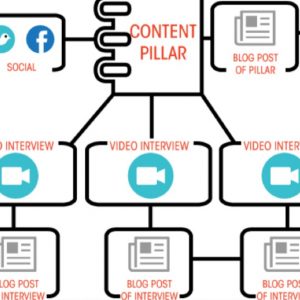Your brand – Where do you want it to be?

Troy Jones and business partner Joe Brooks from JWB & Co, a creative and marketing agency working with educational institutions Australia wide, have been speaking to Educate Plus Chapters about developments in social media and digital marketing. They outlined some fascinating advances in this area which have changed the way we can engage with our communities. Best practice in blanket marketing has evolved dramatically, print and static advertising while a key part of the mix is on the decline. Social media and cutting edge strategies in utilising the paid functionality of the digital platforms can get the right message in front of the right people with immediacy. This brings new and exciting opportunities for communication and engagement.
How do we move our brand from where we are, to where we want to be?
The world has changed. Schools and Tertiary Institutions are now seen as businesses with brands, a concept mostly unheard of just 20 years ago. Branding is critical. A brand is what others think of your product or service and in this instance your institution. It is not what the institution thinks of itself. Sometimes the brand is based on reality, but more often it is based on gross stereotypes. So with that in mind, what does your audience think of your institution? This is critical information to obtain then communicate. This takes time, constancy and consistency.
The more that people know about your institution [messages to communicate] the stronger the brand is likely to be. So the questions are how do I communicate those messages and what do I communicate. Institutions and universities need to know who they are and what they stand for. They must give their audiences a compelling reason to buy as well as to stay!
How or where?
The how is to utilise avenues or in marketing speak, touch points, where your audiences eyeballs are like: online – social media, facebook and instagram, website, email – EDM, and more traditional methods like: direct mail, prospectus, print ads, bill boards to name a few.
Listen to what your audience wants to hear, not just what you want to tell them
You may decide to keep different styles of marketing and communication to suit the different demographics within your community; your prospective parents, parents of both young and older students, new graduates or older old scholars. See what works best for your organisation and find your niche. It’s all about communication targeted to the audience.
Be unique: An attractive student on the bus stop advertisement does not necessarily define your organisation.
What to communicate?
Firstly we need to get feedback from those who know about your institution and build your story/narrative out from there… both internal and if possible external. Robustly analyse opinions. Once you have worked out what your audience thinks of you then you need to create a positioning statement or differentiating idea. A positioning statement is the territory the institution wishes to own, but it is what the institution is known for already and is always authentic, different from your competition, what your audience values and compelling! From this you develop your messaging which underpins and pays homage to the positioning/differentiating idea. Think of this messaging as a book. The positioning as your title, each chapter a different message which relates back to the title. The story you want to tell is not going to be effective if you cannot prove it and as a brand are not doing it. Walk the talk. Awareness building pushing out to your audience of the messaging or chapters must link back to the over arching positioning idea or offer.
A notion that resonated was that of ‘concept pillars’, the authentic and real values of your organisation around which your brand must revolve. These pillars may include academia, sport or music, spiritual values, a sense of social responsibility, or the importance of alumni. These then become the content around which all messages are based. You should be clearly able to differentiate your institution or tertiary institution from the ‘noise’ of your competitors, who are probable saying similar things.
 Once you know your brand, and the pillars which relate to it, you have the structure for all your marketing, (including digital marketing). Talk consistently, repetitively and clearly to these pillars. Work with creative people to tell a story that matches your pillars. Use your students or alumni to engage and inspire your audience. Broaden your base, don’t just talk to the drama parents or the old scholars, provide multiple options for different segments of the community. Listen and work with what people want to hear. They will then share and spread the word through their social networks.
Once you know your brand, and the pillars which relate to it, you have the structure for all your marketing, (including digital marketing). Talk consistently, repetitively and clearly to these pillars. Work with creative people to tell a story that matches your pillars. Use your students or alumni to engage and inspire your audience. Broaden your base, don’t just talk to the drama parents or the old scholars, provide multiple options for different segments of the community. Listen and work with what people want to hear. They will then share and spread the word through their social networks.
Knowing your brand and content pillars is a great place to be, but your marketing needs structure, planning and investment.
Many of our institutions have excellent websites. The first and most important step is getting people to your website, but how do you then link it through social media platforms to reach a much broader and targeted audience? We are all time-poor in the Advancement community, but there are ways of maximising your investment and your time to get better results. Google analytics will give us a number and a location, but who are these people and what are their values and interests? How can we know who they are? Tools are now available which were unheard of 10 years ago, but not many institutions are doing anything in this area.
How do we not get left behind, but more importantly, how do we rise to a level beyond the rest?
Search Engine Marketing (SEM)
You can pay to increase your visibility and thus gain traffic to your website. SEM is a way to create and edit a website so that search engines rank it higher than other competitors’ pages. When a prospective parent enters ‘best institution in Adelaide’ in their search engine, you need SEM to push your institution to the top of the page. This is essential since evidence shows that when people search online, most do not go to the second page. Most institutions are paying zero dollars on SEM, a lost opportunity. You can go to the top of the page!
Search Engine Optimisation(SEO)
Search Engine Optimisation is about getting the search engine (on your behalf) to work out which institution the viewer wants to see, and then to point to you. SEO is free and uses the process of getting traffic through other ‘organic’ or ‘editorial’ search engines. Google and the other search engines use an algorithm involving hundreds of rules to work this out. No one knows the rules and the rules change every week. Ongoing research and time is needed to keep on top of the game, and it needs to be done on a weekly basis to avoid being left behind.
SEO audits are available through external providers who can deliver detailed information from an outside point of view. This can be a valuable tool for your team, as numbers and charts will clarify their thinking and see what is needed for your institution or organisation to outshine the rest.
Paid advertising can target a specific audience at a specific location or time around the world.
Digital Advertising
Whilst print advertising, static signage, radio and television advertising is declining, digital advertising expenditure has doubled worldwide in the last two years. Yet despite this trend, 80% of institutions are currently spending nothing in this arena. Digital advertising allows marketers to reach their core audience in new ways with more precision. Paid functionality is an essential feature of digital advertising, and is a growing opportunity for institutions to grasp. This is achieved through ‘tracking pixels’. It can track what a person has been looking at on a search engine and then transfer it to another social media platform. For example, you look at a pair of shoes on an online site, then open your Facebook page…and there they are! The information is interchangeable.
You can put tracking pixels on your website, perhaps on the Early Learning Centre page, the Boarding House page or the Alumni reunions page. With those details, with the right help, you can get the right content onto their Facebook page, regardless of whether they follow you or not. You too can engage this strategy and make your dollar work more for you. This technology is just the tip of the iceberg! Another level of marketing and engagement!
It’s all about your audience.
Retargeting
 Email addresses are the most powerful tool available to us as marketers. We all have these email lists from an Open Day, Enrolment Tour, Country Field Day or International Marketing Exhibition. Emails can be used to connect your organisation to a person’s own personal Facebook page, and to all their Facebook friends! This is called Retargeting.
Email addresses are the most powerful tool available to us as marketers. We all have these email lists from an Open Day, Enrolment Tour, Country Field Day or International Marketing Exhibition. Emails can be used to connect your organisation to a person’s own personal Facebook page, and to all their Facebook friends! This is called Retargeting.
Retargeting is a form of online advertising that can help you keep your brand at front of mind, even after the viewer leaves your website. You don’t know who these people are, you just know their email contact. You are then putting your information in front of them in a social media setting.
This raises an interesting question for institutions and universities, and some may challenge the ethics and privacy issues of this approach. However, what we are really saying is ‘We are following up on interest you have had in our website, so here is some information about our institution for you to consider’. Important here, is gentle, subtle messages that gather attention.. not force it.
For most websites only 2% of web traffic converts to a response on the first visit, and it takes around 8 brushes with a message to get a proactive response. Retargeting or remarketing is a great ‘follow-up’ tool and one of the approaches to get the right information in front of the right person. It can be a useful tool for managing enrolment waiting lists and keeping the message fresh.
Lookalike audiences
This is another example of paid advertising which reaches new people who are likely to be interested in your organisation since they have similar values, interests and behaviours to your current parents or alumni, those who are already familiar with, and like your brand. Facebook’s lookalike audiences tool is effective in reaching a broad, ideal target audience through identifying key similarities and predicting what sort of messages they will be most receptive to. Lookalike audiences are an amazing new way to link with future potential customers.
Again, in a time poor Advancement environment you may need professional help in putting this strategy in place.
Marketing is all about communication. What do people want?
 Marketing, in whatever form, is all about communicating and engaging with your audience. The message needs to follow the content pillars and fit your brand in an authentic way. Build a number or short stories around your content pillars to address different interests. Create a framework using your students, staff, parents or alumni. Make your story short, catchy and creative with a definite and memorable ‘aha’ moment. Remember, don’t leave the punch line until the end and make your message inspiring, engaging and warm. Make it worthwhile, and the beginning of an ongoing conversion that your audience wants to return to.
Marketing, in whatever form, is all about communicating and engaging with your audience. The message needs to follow the content pillars and fit your brand in an authentic way. Build a number or short stories around your content pillars to address different interests. Create a framework using your students, staff, parents or alumni. Make your story short, catchy and creative with a definite and memorable ‘aha’ moment. Remember, don’t leave the punch line until the end and make your message inspiring, engaging and warm. Make it worthwhile, and the beginning of an ongoing conversion that your audience wants to return to.
Marketing has become a science. Embrace the tools available to take your organisation to the next level, a level beyond the rest.
This article is an account of the JWB & Co, Educate Plus PD sessions.
No part of this article can be reproduced or distributed without the written consent of Educate Plus and JWB & Co.
This article can be shared on the following social media channels.
@Educate_Plus












 Once you know your brand, and the pillars which relate to it, you have the structure for all your marketing, (including digital marketing). Talk consistently, repetitively and clearly to these pillars. Work with creative people to tell a story that matches your pillars. Use your students or alumni to engage and inspire your audience. Broaden your base, don’t just talk to the drama parents or the old scholars, provide multiple options for different segments of the community. Listen and work with what people want to hear. They will then share and spread the word through their social networks.
Once you know your brand, and the pillars which relate to it, you have the structure for all your marketing, (including digital marketing). Talk consistently, repetitively and clearly to these pillars. Work with creative people to tell a story that matches your pillars. Use your students or alumni to engage and inspire your audience. Broaden your base, don’t just talk to the drama parents or the old scholars, provide multiple options for different segments of the community. Listen and work with what people want to hear. They will then share and spread the word through their social networks. Email addresses are the most powerful tool available to us as marketers. We all have these email lists from an Open Day, Enrolment Tour, Country Field Day or International Marketing Exhibition. Emails can be used to connect your organisation to a person’s own personal Facebook page, and to all their Facebook friends! This is called Retargeting.
Email addresses are the most powerful tool available to us as marketers. We all have these email lists from an Open Day, Enrolment Tour, Country Field Day or International Marketing Exhibition. Emails can be used to connect your organisation to a person’s own personal Facebook page, and to all their Facebook friends! This is called Retargeting. Marketing, in whatever form, is all about communicating and engaging with your audience. The message needs to follow the content pillars and fit your brand in an authentic way. Build a number or short stories around your content pillars to address different interests. Create a framework using your students, staff, parents or alumni. Make your story short, catchy and creative with a definite and memorable ‘aha’ moment. Remember, don’t leave the punch line until the end and make your message inspiring, engaging and warm. Make it worthwhile, and the beginning of an ongoing conversion that your audience wants to return to.
Marketing, in whatever form, is all about communicating and engaging with your audience. The message needs to follow the content pillars and fit your brand in an authentic way. Build a number or short stories around your content pillars to address different interests. Create a framework using your students, staff, parents or alumni. Make your story short, catchy and creative with a definite and memorable ‘aha’ moment. Remember, don’t leave the punch line until the end and make your message inspiring, engaging and warm. Make it worthwhile, and the beginning of an ongoing conversion that your audience wants to return to.